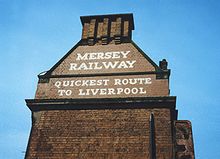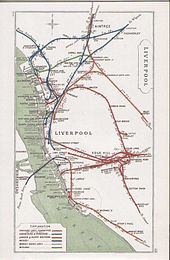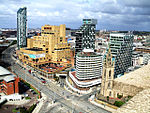- Mersey Railway
-
 Original Mersey Railway painted sign on Birkenhead Central station, the company's former headquarters.
Original Mersey Railway painted sign on Birkenhead Central station, the company's former headquarters.
The Mersey Railway connected Liverpool and Birkenhead, England, via the Mersey Railway Tunnel under the River Mersey. Opened in 1886, it was the second oldest urban underground railway network in the world.[citation needed] The railway contained the first tunnel built under the River Mersey. It was constructed by John Waddell, who had been sub-contracted the work by Major Samuel Isaac. The Mersey Railway remained independent in the railway grouping of 1923, although it became very closely integrated with the LMS electric services operated over the former Wirral Railway routes from 1938. The Mersey Railway was nationalised, along with most other rail services, in 1948.
Contents
Design
The Mersey Tunnel was designed by Sir Charles Fox, and the design was carried out by his son, Douglas Fox, a Civil Engineer who was joint engineer to the Mersey Tunnel Company (set up in 1866) with James Brunlees. Douglas Fox was later knighted for his work on the project after its official opening by the Prince of Wales, later King Edward VII. Charles Fox & Son, later known as Sir Douglas & Francis Fox is still in existence today trading as Hyder Consulting.
Opening and extensions
 A 1913 Railway Clearing House Junction Diagram showing railways in Birkenhead, including part of the Mersey Railway (purple)
A 1913 Railway Clearing House Junction Diagram showing railways in Birkenhead, including part of the Mersey Railway (purple)
 A 1909 Railway Clearing House Junction Diagram showing railways in Liverpool, including part of the Mersey Railway (purple)
A 1909 Railway Clearing House Junction Diagram showing railways in Liverpool, including part of the Mersey Railway (purple)
The Mersey Railway opened between Green Lane station in Birkenhead and James Street station in Liverpool in 1886, via Birkenhead Central and Hamilton Square stations, both in Birkenhead. James Street and Hamilton Square station were very deep, so deep only lifts could access the stations. Green Lane and Birkenhead Central stations were below ground level, however in open cuttings. In 1888 a branch to Birkenhead Park station opened, with a connection to the Wirral Railway. This was followed in 1891 by an extension from Green Lane to Rock Ferry with a connection to the Birkenhead Railway. In 1892 the tunnel was extended from James Street to a new Low Level station at Liverpool Central. The total length of the tunnel was 3.12 miles (5029 m) and by 1890 it was carrying 10 million passengers a year.
Steam locomotives
For the opening of the line, eight powerful 0-6-4T tank locomotives were obtained from Beyer, Peacock and Company. These were fitted with condensing apparatus for working in the tunnel. One of them (number 5 Cecil Raikes) is preserved at the Museum of Liverpool. It is likely that it is named after Henry Cecil Raikes who was Member of Parliament for Preston in 1882. Beyer Peacock built a ninth 0-6-4T locomotive in 1886, along with six 2-6-2T tank locomotives in 1887–1888. A seventh 2-6-2T was built by Kitson & Co in 1892.
After electrification four of the Railway's 0-6-4T locomotives were sold to J. & A. Brown of New South Wales, Australia, where one, number 5, former Mersey Railway number 1 The Major, is preserved at the New South Wales Rail Transport Museum, Thirlmere, New South Wales.[1] Three other 0-6-4T (nos. 2, 3 & 6) and all seven 2-6-2T locomotives (nos. 10-16) were sold to the Alexandra (Newport and South Wales) Docks and Railway between November 1903 and January 1905, becoming their nos. 6-11 and 22-25. All ten passed to the Great Western Railway in January 1922, and were withdrawn between January 1923 and May 1932.[2][3]
Electrification
In 1903, the railway was electrified, becoming the first underground railway in the world to change over completely from steam to electric power.[4] It was originally electrified with a fourth rail system,[citation needed] which was later replaced by a third rail system. The nearby Liverpool Overhead Railway, the world's first electric overhead railway, had already operated successfully with electric traction since its opening in 1893.[5]
The Mersey Railway electric trains ran from Liverpool Central to Birkenhead Park and to Rock Ferry, where passengers to points beyond would change. In 1938 the LMS electrified from Birkenhead Park to New Brighton and to West Kirby, and built new trains which ran through to Liverpool. Normally new LMS trains handled the West Kirby route and Mersey Railway trains handled the New Brighton service, as well as the existing Rock Ferry operation. In 1948, on nationalisation of the railways, the Mersey Railway became known as the London Midland Region Mersey section and the old cars were renumbered in the British Railways sequence. In 1956 these trains were life-expired and replaced by further trains built to the LMS 1938 design, the last of the American-designed cars being phased out a year later.
Current Use
The tunnel and railway are still in use today as part of the Wirral Line of the Merseyrail commuter rail network.
See also
- Shore Road Pumping Station with pumps which remove water from the tunnel under the River Mersey
External links
- A Stevengraph of the Mersey Railway Tunnel
- Article from Scientific American on the opening of the tunnel from Project Gutenberg
- UrbanRail.net article on Merseyrail
- Preserved locomotive Cecil Raikes
References
Notes
- ^ "New South Wales Rail Transport Museum - J & A Brown 5". http://www.nswrtm.org/exhibits/the_exhibits/jab5.html. Retrieved 13 November 2008.
- ^ Casserley & Johnston 1966, pp. 113–115
- ^ RCTS GWR Part 10, p.K17
- ^ Awdry 1990, p. 224
- ^ Awdry 1990, p. 221
Bibliography
- Awdry, Christopher (1990). Encyclopaedia of British Railway Companies. London: Guild Publishing. CN 8983.
- Casserley, H.C.; Johnston, S. W. (1966). Locomotives at the Grouping 4: Great Western Railway. Shepperton, Middlesex: Ian Allan Limited.
- "New South Wales Rail Transport Museum - J & A Brown 5". http://www.nswrtm.org/exhibits/the_exhibits/jab5.html. Retrieved 13 November 2008.
- Reed, P.J.T. (April 1966). Absorbed Engines 1922-1947. The Locomotives of the Great Western Railway. Part 10. Railway Correspondence and Travel Society.
Next crossing upstream River Mersey Next crossing downstream Runcorn Railway Bridge Mersey Railway Queensway Tunnel Categories:- Rail transport in Liverpool
- Rail transport in Merseyside
- Pre-grouping British railway companies
- Railway tunnels in England
- Railway lines opened in 1886
- Railway companies disestablished in 1923
- Tunnels completed in 1886
Wikimedia Foundation. 2010.






